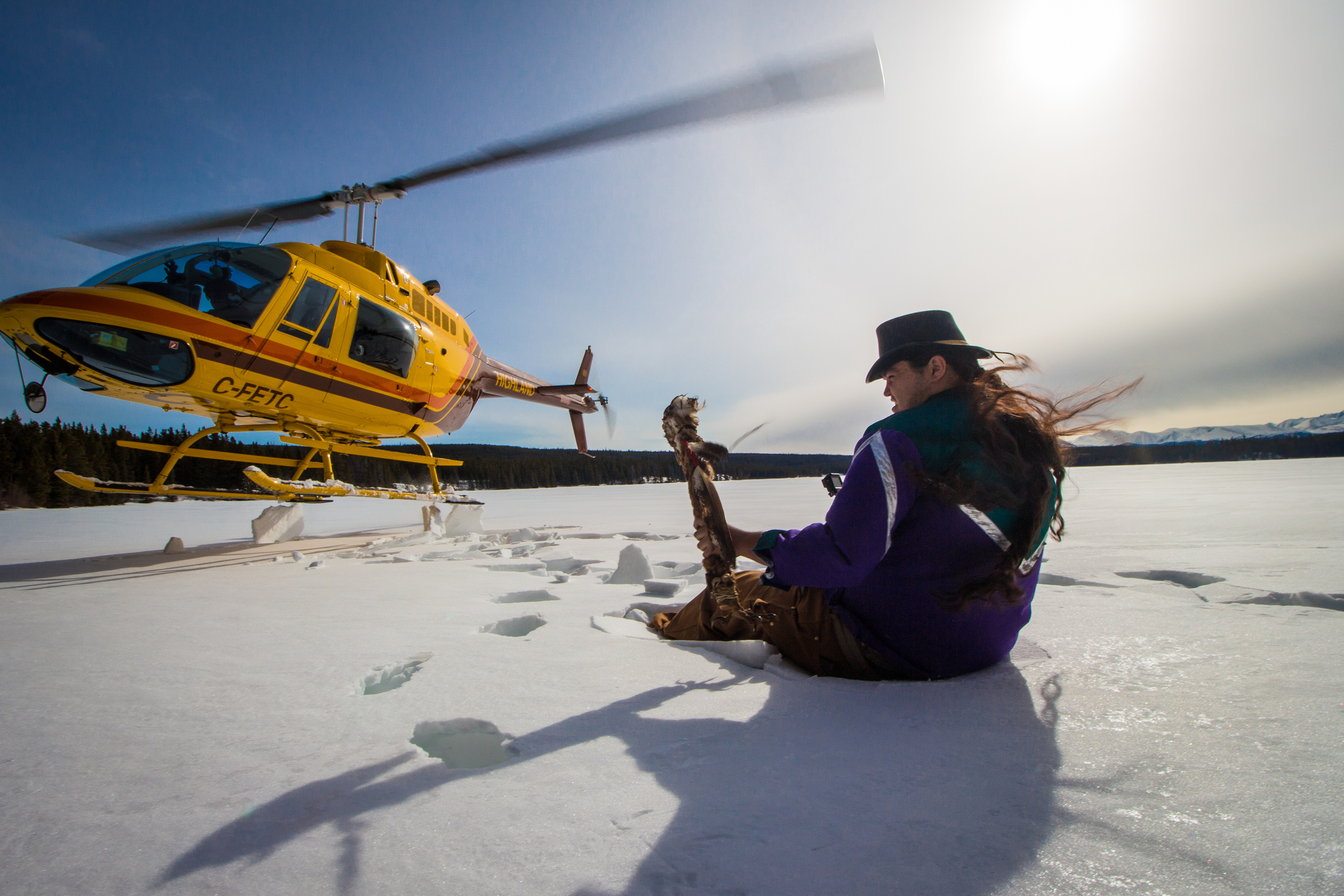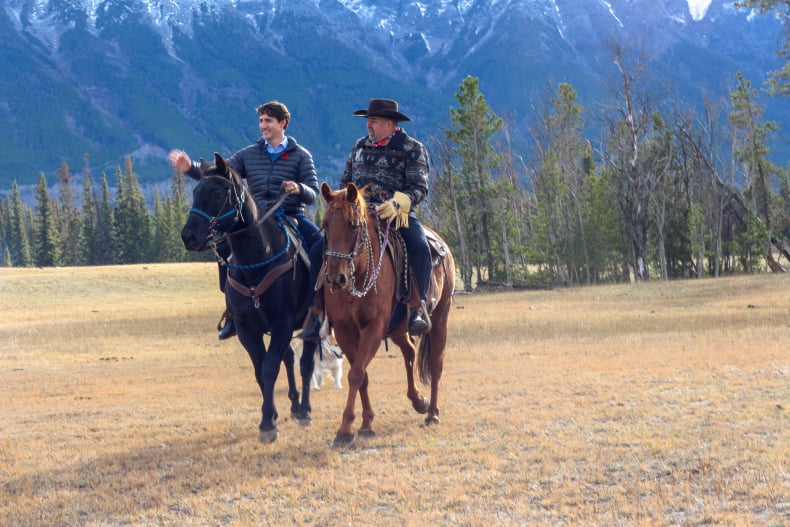Support strong Canadian climate journalism for 2025
Members of the Tŝilhqot’in nation gathered for a peaceful protest against exploratory drilling construction at a sacred lake in their territory in the latest move in what Tŝilhqot’in leadership calls an ongoing “spiritual war.”
Three Tŝilhqot’in youth stayed up all night, waiting for construction equipment the next morning. As early as 6 a.m., trucks came rolling through. The youth called on Tŝilhqot’in spiritual ambassador Cecil Grinder and other community members, and stopped trucks in their path. More community, from a 10-month-old baby to a group of elders, arrived in a unified show of support, met three hours later by the official spokesperson for Taseko Mines, who they told they did not want mining construction in their territory - yesterday, today or tomorrow.
Eventually the heavy equipment and team behind it turned around and headed home.
It’s the latest move in what has been decades-long fight to protect Teẑtan Biny (Fish Lake) from mining construction that would devastate land, waters, rights and ways of life for the nation. While the nation has been dragged in and out of Canadian courts for the last 20 years, trying to prevent any related mining activity, leadership say that their actions uphold Tŝilhqot’in laws first and foremost.
The Tŝilhqot’in nation is the only nation in Canada to have won recognition of Aboriginal rights and title at the Supreme Court, in a case that took over 25 years.
Last week, on June 27, on the five-year anniversary of the historic title and rights victory, elected Tŝilhqot’in chiefs, spiritual ambassadors, politicians and community members joined together for a water ceremony in preparation for what seems like a never-ending fight to protect Teẑtan Biny and the surrounding area.
The water at Teẑtan Biny trickles into the Fraser River, the longest river in B.C., and makes its way to the Pacific Ocean. The health of the headwaters affects the health of all connected bodies of water, people and places, including sockeye salmon, the keystone species of the entire West Coast.
Despite having proven title at the high court, Tŝilhqot’in chiefs and community members say they're disappointed to be continuously dragged through court battles, trying to prevent mining-related activities at one of the highest elevation lakes in Tŝilhqot’in territory.
“Even if the Supreme Court of Canada says you have rights and title, it seems like it doesn’t mean anything,” said elected chief of Tl’esqox (Toosey) Francis Laceese. “This whole issue comes down to human rights. We’re no different from any other nation in the world that has industries abusing their rights for profit. The genocide is still here, it hasn’t left," chief Laceese told a packed room at the Victoria event centre last week when the nation held a water ceremony to spiritually prepare community members and allies for what they expect will be a long journey of peaceful protection.

In 2008, Taseko Mines Limited first proposed a $1.5-billion open-pit copper and gold mine, which would drain Teẑtan Biny.
Horrified by Taseko Mines' proposal, leadership asked community members whether they would engage with an environmental assessment meant to determine the impacts of what would be one of the biggest copper and gold mines in the world. In 2010, community members rounded up and packed into halls for a lengthy environmental assessment panel. Everyone from elders and children shared stories of their use of the lake and surrounding areas for hunting, fishing, trapping, ceremonies, cultural camps and more. At the end of the day, an independent panel wrote a scathing report of the mine, saying the area was "of unique and special significance to the Tŝilhqot’in."
The Harper government rejected the mine a first time.
Within three months, Taseko came forward with a new proposal for “New Prosperity Mine,” which the Tŝilhqot’in saw as having the same devastating impacts on their territory and associated way of life. The new proposal called for a new panel and new independent experts. Communities discussed how much faith they had in yet another lengthy assessment, but the nation made the decision to fully and actively participate despite their doubts. Three new independent experts said the mine would endanger the Tŝilhqot’in and once again, the federal government rejected New Prosperity Mine.
As it stands, the mine is rejected and cannot legally be built.
But, in 2017, on the day of transition from the B.C. Liberals to the NDP, an exploratory drilling permit for "pre-construction work" was granted to Taseko mines, a decision that came while Tŝilhqot’in communities were being evacuated due to wildfires. It was a shock to the community and "a slap in the face" that the provincial government could make such a decision on their last day in power, Tribal Chief Joe Alphonse said in an interview in March of this year.

The drilling program permits 76 kilometres of new or modified road and trail, 122 drill holes, 367 excavated test pits and 20 kilometers of seismic lines.
The Tŝilhqot’in National Government (TNG) filed for a judicial review of the permit, and applied for an injunction to prevent the activity while the judicial review was heard. TNG was in B.C. Supreme Court for three days in early August 2017 seeking an injunction. The Canadian Environmental Assessment Agency (CEAA) also took legal action against the program in 2017, arguing that the drilling was in violation of the Canadian Environmental Assessment Act. CEAA eventually sought a statutory injunction that that B.C. Supreme Court chose not to grant in June 2018.
Following CEAA’s unsuccessful outcome, TNG reactivated its judicial review and injunction proceedings. TNG was able to secure injunctions against the drilling but twice was unsuccessful in court to overturn the drilling permit (first at the B.C. Supreme Court, then the BC Court of Appeal). In March 2019, following a B.C. Court of Appeal decision upholding the drilling permit, TNG applied for leave to appeal at the Supreme Court. On June 13, they learned that the SCC denied leave.
On June 27, Taseko Mines wrote to the Tŝilhqot’in Nation, advising that it would mobilize heavy equipment, including logging and road-clearing equipment, starting July 2.
Taseko Mines has already started to mobilize personnel and machinery in the area, while the nation has also mobilized, lighting sacred fires last night, gathering elders, leadership and community members together to face off in a peaceful protest against the company.

“This project is dead. It cannot be built. Yet the company wants to come in and tear up a place that is as sacred to us as a church,” wrote Chief Joe Alphonse in a press release sent to media yesterday. “We are deeply concerned about this escalating conflict. As a Nation, our top priority is the safety and security of our own members, and TML employees and contractors. That’s why our Nation must take peaceful action to prevent this situation from getting out of control."
At the water ceremony last Wednesday, Andrew Weaver, leader of the B.C. Green Party, asked Racelle Kooy, Green party candidate for Victoria, to speak on his behalf. "Indigenous communities have had too many white politicians talking at them and not listening to them," Weaver explained to National Observer on his way out of the event.
“Andrew Weaver said he wants to listen and make space for us to do the good work,” Kooy announced. Kooy, who's Secwepemc and Stamimc, participated in the 2010 environmental assessment to say 'NO' to the proposed 'New Prosperity Mine.' “I still say NO today, NO to the New Prosperity Mine, and yes to Free and Prior Informed Consent.”
Weaver said he knows the story of the Tŝilhqot’in's fight to protect Fish Lake quite well, and he empathized with the frustration he heard expressed again that day. His main concern, as a politician, has to do with the decision-making process to grant the permit for the extensive drilling program, he told National Observer.
“Questions need to be asked. This mine was rejected twice, so what is going on? I’m not sure how the drilling program went forward. We have governments federally and provincially committed to the United Nations Declaration on the Rights of Indigenous Peoples and its egregious to see what’s going on,” Weaver said.
“The province has a duty to uphold the honour of the Crown, which at some point, you might say to hide behind it... I don’t know what the legal ramifications would be, but we need to know what the rationale behind their decision was, and through those answers, perhaps we can pull together the case,” Weaver said.
“Nowhere else has a Nation been subjected to not one but two federal environmental reviews, both confirming the cultural and spiritual importance of this place to our people, and which led to two federal rejections of the mine,” wrote Chief Jimmy Lulua of Xeni Gwet’in in a press release sent out yesterday. “We are looking for the same kind of leadership in Premier John Horgan now. The Province of B.C. has the tools they need to intervene, but until now appeared unwilling to show leadership and resolve this conflict once and for all. Now is the time to finally act.”
There is a tool in the Mineral Tenure Act that allows the provincial government to protect a cultural heritage site from mining activity, without compensation. A "cultural heritage resource" means an object, a site or the location of a traditional societal practice that is of historical, cultural or archeological significance to British Columbia, a community or an Aboriginal people.
National Observer contacted the B.C. Ministry of Energy, Mines and Petroleum Resources and asked whether they considered taking this approach, or whether they had justifiable grounds for revoking the permit. Kent Karetaker, communications officer for the ministry, didn't comment on the Mineral Tenure Act, but provided background information, writing in an email that the "longstanding and complex manner was inherited" from the previous government.
"Our government is committed to continuing our work with the Tsilhqot'in to build a shared understanding of land and resource management priorities and opportunities across the territory. This is a key component of our work together under the Nenqay Deni Accord," Karetaker wrote. "We recognize TNG's decision to peacefully voice their opposition at the project site. We will continue working with all parties to keep the dialogue open so that the potential for any conflict is minimized."
The Ministry of Indigenous Relations and Reconciliation and Taseko Mines have also confirmed requests for comment and responses will be added if and when they are received.
In March, Suzannah Kelly, a B.C. public affairs officer wrote in an email that the long-standing, complex matter was inherited by the previous government and is being dealt with in the courts.
This article was updated at 5:50 p.m. PT to include comments from the B.C. Ministry of Energy, Mines and Petroleum Resources.








Comments
Thank you for your thorough reporting on this story Emilee. It is hard to find that in mainstream media. I'm hoping the BC Government will do something to intervene, but they seem reluctant to do so. This is so contrary to the federal and provincial governments and society's commitment to Reconciliation.
Thanks for your feedback, Patricia. As a reporter, I have found it difficult to get a straight response to whether or not there are any tools in the province's toolbox, to be able to protect this site or revoke the permits. I keep hearing that the problem was inherited, and one they're dealing with, period. It will be interesting to see how things progress.
These headwaters are the birth place of salmon and all that depend on her. Weaver's bureaucratic mumbo jumbo is revealing. Eternal gratitude and support to the T'silhqot'in Nation for sending the zombie mining packing. I stand with you.
Thanks for your heartfelt comment. The headwaters are sacred to the nation and all communities that depend on this keystone species along the way.
I thought this matter was put to rest 5 years back. To destroy this beautiful part of BC would truly be a travesty.
From speaking to the nation over the past year, community members and leadership seem discouraged by the amount of times (not to mention the energy and resources it takes) they are dragged back through court to try and attain injunctions to prevent construction. If it's not the mine, it's a drilling program. But this roadblock is an indicator that they will not rest - what will happen next?
For 10 years I've fought hard alongside Tsilqot'in & countless others against Taseko's monstrous (twice fed-rejected) plans, which would devastate not only this sacred BC interior ('last frontier') wilderness but the headwaters of Fraser River & aLL its dependent living species --incl. humans. Any doubts about this project's ruinous effects are quickly erased by this crushing in-depth NYT investigation into the unmitigated tolls on a once-pristine heritage ecosystem by an [equivalent] operation sTill wreaking havoc after 50+ deadly years: https://www.nytimes.com/2005/12/27/world/asia/below-a-mountain-of-wealt…
You may also read one of my many letters over the years submitted for the Federal Assessment(s) of (New) Prosperity Mine, which delves into detail about the project's ruinous effects on its surroundings, with comparisons to other similar projects worldwide, as well as on the Fraser River & its many dependent living species (incl. humans!) at this link: https://planetsedge.wordpress.com/2010/06/07/letter-to-govt-re-prosperi…
Thanks for sharing